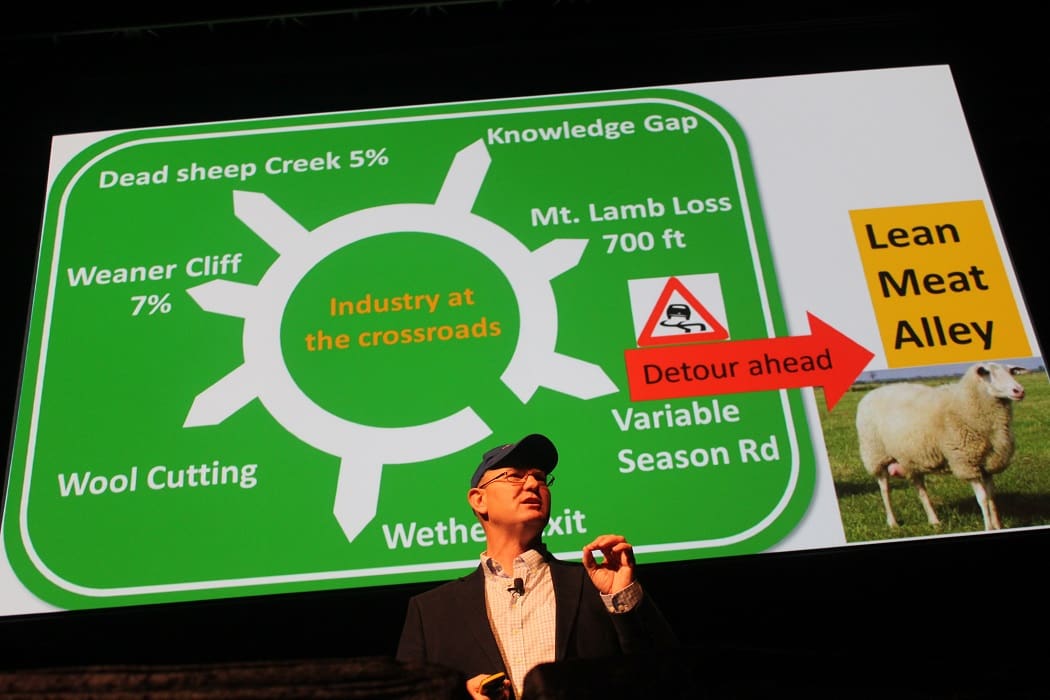
Consultant Jason Trompf leads Lambex 2018 delegats through the lamb supply pitfalls.
AUSTRALIA’S sheep producers will need to produce more lambs from fewer ewes to meet world sheep meat market demand and unlock value in a differentiated product, consultant Jason Trompf told the recent Lambex 2018 conference in Perth.
“As you see the global demand for our product grow, there is an insatiable appetite for our product, but our breeding population of sheep is going nowhere.
“So we have to produce more from less to meet that demand and we have a serious opportunity to address that,” he said.
Mr Trompf told delegates at the conference that only two thirds of Australia’s ewe base currently reared a lamb, but this could be lifted to 90 percent.
“So a third are glorified wethers and the hidden factor in this is the lamb survival opportunity.”
Mr Trompf said although record national marking rates of greater than 90pc have been achieved, limited lamb supply is a major constraint for the value chain and only 70 percent of lambs scanned in ewes in Australia made it through to marking.
“We can reduce that (30pc loss) to 10pc using best practice management, which is where some farmers are at now.
“Going from current practice to best practice, after the cost of production, is worth $1 billion profit each year (based on a lamb value of 600c/kg cwt) to an industry that is worth $7-$8 billion in total,” he said.
“The thing in that number that is not calculated though is the fact that supply influences our ability to get more disciplined in our market signals.”
Objective carcase measurement via DEXA and robotic cutting had the potential to deliver $420 million/year in extra value, but Mr Trompf said clear market signals in the lamb industry require more than a technological solution. It would require widespread industry adoption and adequate supply to allow tighter specifications to be implemented and adhered to.
“There is hardly a processor in the country that’s going to use DEXA lean meat yield and eating quality market signals under the current supply regime,” Mr Trompf said.
“How we get a return on that investment is differentiation.”
Mr Trompf said there will not be much differentiation in a tight supply situation.
“Most of the processors back off on the tightness of their grids when there is limited supply and we get the benefits of these new tools with market signals that drive continuous improvement in compliance.”
Mr Trompf said 60pc of Australian lambs are currently sold through saleyards.
“And if you want to talk about disconnect, of the 40pc, half of them are sold via an agent also.
“Probably only about 20pc of the lambs in the country are traded direct from farmer to processor, so yes, there is a connectivity challenge.”
Lamb supply challenge is ‘end-to-end’

Jason Trompf at Lambex 2018
But Mr Trompf said the lamb survival opportunity is one of the few that is “end-to-end”.
“Clearly it affects production and profit and welfare outcomes on farm, it affects our supply and our ability to fill our processing plants and then differentiate the product with tighter specifications that the industry needs.
“And the third thing, which is the trump card, is the downside risk, and the fact that we have to meet expectations around our industry in this area of lamb survival,” he said.
In an extended presentation involving speakers from the sheep meat processing, services and marketing sectors, Mr Trompf outlined the ‘sheep supply chain balancing act’ of meeting market demand for various lamb and mutton products from the declining national flock.
His presentation outlined how in the last 20 years, the gross value of Australia’s sheep and wool production has increased by $5 billion (from $3bn to $8bn-plus in 2017-18), while the flock has declined by 70 million sheep to a national flock including only 40 million breeding ewes.

“Australia needs to produce more lambs from less ewes” – the CSIRO and MLA spent significant amounts of money to solve this problem. The results of this investment are provided in the Multimeat genotype which can deliver weaning rates of 160 percent. The major cause of inefficiency in the Australian lamb industry was the inherently low fecundity of the genotypes available. That is why so much money was spent to develop the Multimeat.